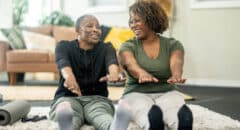
Planks are one of those exercises that you hear about, but don’t hear about enough. Most people stick to their routine and don’t include planks in most of them. But a plank is an exercise that should be included because it literally transforms our body from the inside out.
To perform a basic plank, you should:
– Get into a press up position. Bend your elbows and rest your weight on your forearms.
– Your body should form a straight line from shoulders to ankles. Make sure your hips, head and shoulders don’t drop.
– Engage your core by pulling your belly into your spine.
– Hold this position for 15 to 90 seconds depending on what you are able for. Remember, it’s better to maintain proper form for a shorter period of time than to hold improper form for a long time.
– Rest for approximately one minute and repeat three to five more times.
1. You’ll Speed Up Your Metabolism
Planking is an excellent way of challenging your entire body because doing them every day will burn more calories than other traditional abdominal exercises, such as crunches or sit-ups. The muscles you strengthen by doing this exercise on a day-to-day basis will ensure that you burn more energy even when sedentary. This is especially important if you are spending the majority of your day sitting in front of a computer. Also, making it a daily 10- to 1 minute home exercise before or after work will not only provide an enhanced metabolic rate but it will also ensure that that metabolic rate remains high all day long, (yes, even while you are asleep).
2. Your Stomach Will Flatten & Core Strength Will Improve
One of the top benefits of doing planks regularly is that they strengthen the core – those muscles, bones, and joints that link the upper and lower body. Because we engage the core constantly during everyday life – when we lift, turn, reach and bend – it’s probably the most important area of the body to work on.
Successfully holding the plank position requires that you squeeze and engage all the main core muscle groups – the transverse abdominus, the rectus abdominus, the external oblique muscle, and the glutes. When core strength improves, everyday tasks become easier, we feel stronger and our athletic ability improves.
A study published in the Journal of Strength and Conditioning found that the plank provides 100% activation of your six-pack muscles whereas crunches only engage 64%.
Regular plank practice means your abdominal muscles will become stronger, and will tighten up. Plus, you’ll be toning other areas of your body too, giving you more bang for your buck.
3. Everyday Tasks Will Become Easier
Planks are classed as a ‘functional exercise’ because the benefits they bring translate into ‘real-world’ activities – just one of the reasons why some Navy personnel advocate replacing the sit-up in the Navy’s physical-readiness test with the plank.
When undertaken regularly, planking sessions make real life tasks easier because they don’t focus on single muscles, but are designed to utilize several groups of muscles all at once – exactly how our body is designed to function.
As you lose fat, build muscle and strength; improve flexibility, bone and joint health; and enjoy increased mobility and balance you should notice things like shopping, cleaning, decorating and gardening all require much less physical exertion!








